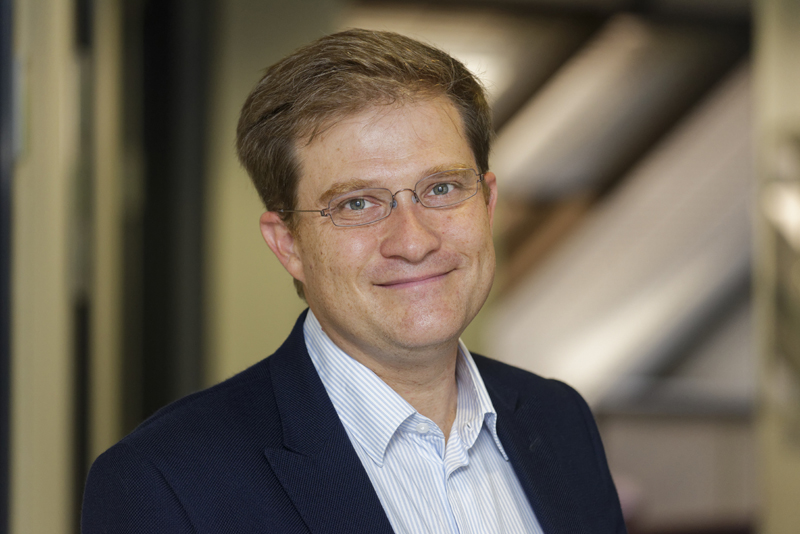Research and economic impacts: “intelligent together”
What connections currently exist between the world of academic research and the economic sphere? Does the boundary between applied research and fundamental research still have any meaning at a time when the very concept of collaboration is being reinterpreted? Godefroy Beauvallet, Director of Innovation at IMT and Vice Chairman of the National Digital Technology Council provides some possible answers to these questions. During the Digital Technology Meetings of the French National Research Agency (ANR) on November 17, he awarded the Economic Impact Prize to the Trimaran project, which unites Orange, Institut Paul-Langevin, Atos, as well as Télécom Bretagne in a consortium that has succeeded in creating a connection between two worlds that are often wrongly perceived as opposites.
When we talk about the economic impact of research, what exactly does this mean?
Godefroy Beauvallet: When we talk about economic impact, we’re referring to research that causes a “disruption,” work that transforms a sector by drastically improving a service or product, or the productivity of their development. This type of research affects markets that potentially impact not just a handful, but millions of users, and therefore also directly impact our daily lives.
Has it now become necessary to incorporate this idea of economic impact into research?
GB: The role of research institutions is to explore realities and describe them. The economic impacts of their work can be an effective way of demonstrating they have correctly understood these realities. The impacts do not represent the compass, but rather a yardstick—one among others—for measuring whether our contribution to the understanding of the world has changed it or not. At IMT, this is one of our essential missions, since we are under the supervision of the Ministry of the Economy. Yet it does not replace fundamental research, because it is through a fundamental understanding of a field that we can succeed in impacting it economically. The Trimaran project, which was recognized alongside another project during the ANR Digital Technology Meetings, is a good example of this, as it brought together fundamental research on time reversal and issues of energy efficiency in telecommunication networks through the design of very sophisticated antennas.
So, for you, applied research and fundamental research do not represent two different worlds?
GB: If we only want a little economic impact, we will be drawn away from fundamental research, but obtaining major economic impacts requires a return to fundamental research, since high technological content involves a profound understanding of the phenomena that are at work. If the objective is to cause a “disruption”, then researchers must fully master the fundamentals, and even discover new ones. It is therefore necessary to pursue the dialectic in an environment where a constant tension exists between exploiting research to reap its medium-term benefits, and truly engaging in fundamental research.
“If the objective is to cause a disruption, then researchers must fully master the fundamentals”
And yet, when it comes to making connections with the economic sphere, some suspicion remains at times among the academic world.
GB: Everyone is talking about innovation these days. Which is wonderful; it shows that the world is now convinced that research is useful! We need to welcome this desire for interaction with a positive outlook, even when it causes disturbances, and without compromising the identity of researchers, who must not be expected to turn into engineers. This requires new forms of collaboration to be created that are suitable for both spheres. But failure to participate in this process would mean researchers having to accept an outside model being imposed on them. Yet researchers are in the best position to know how things should be done, which is precisely why they must become actively involved in these collaborations. So, yes, hesitations still exist. But only in areas where we have not succeeded in being sufficiently intelligent together.
Does succeeding in making a major economic impact, finding the disruption, necessarily involve a dialogue between the world of research and the corporate world?
GB: Yes, but what we refer to as “collaboration” or “dialogue” can take different forms. Like the crowdsourcing of innovation, it can provide multiple perspectives and more openness in facing the problems at hand. It is also a reflection of the start-up revolution the world has been experiencing, in which companies are created specifically to explore technology-market pairs. Large companies are also rethinking their leadership role by sustaining an ecosystem that redefines the boundary between what is inside and outside the company. Both spheres are seeking new ways of doing things that do not rely on becoming more alike, but rather on embracing their differences. They have access to tools that propose faster integration, with the idea that there are shortcuts available for working together more efficiently. In our field this translates into an overall transformation of the concept of collaboration, which characterizes this day and age –particularly due to the rise of digital technology.
From a practical perspective, these new ways of cooperating result in the creation of new working spaces, such as industrial research chairs, joint laboratories, or simply through projects carried out in partnership with companies. What do these working spaces contribute?
GB: Often, they provide the multi-company context. This is an essential element, since the technology that results from this collaboration is only effective and only has an economic impact if it is used by several companies and permeates an entire market. The company is then under certain short-term requirements, with annual or even quarterly requirements. From this point of view, it is important for the company to work with actors who have a slower, more long-term tempo; to ensure that it will have a resilient long-term strategy. And these spaces work to build trust among the participants: the practices and interactions are tightly regulated legally and culturally, which protects the researchers’ independence. This is the contribution of academic institutions, like Institut Mines-Télécom, and public research funding authorities, like ANR, which provide the spaces and means for inventing collaborations that are fruitful and respectful of each other’s identity.





Leave a Reply
Want to join the discussion?Feel free to contribute!